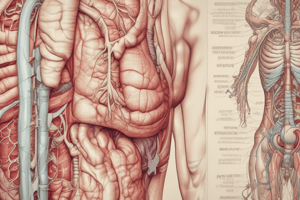Podcast
Questions and Answers
Which of the following layers is NOT a component of the mucosa?
Which of the following layers is NOT a component of the mucosa?
- Lamina propria
- Submucosa (correct)
- Muscularis mucosae
- Epithelial lining
What is the primary function of the digestive system?
What is the primary function of the digestive system?
- To break down food into absorbable molecules (correct)
- To regulate blood sugar levels
- To transport nutrients to the bloodstream
- To eliminate waste products from the body
What is the primary component of the submucosa?
What is the primary component of the submucosa?
- Epithelial tissue
- Lymphatic tissue
- Smooth muscle tissue
- Connective tissue (correct)
Which of the following is a characteristic of the muscularis mucosae?
Which of the following is a characteristic of the muscularis mucosae?
What is the function of the myenteric (Auerbach's) nerve plexus?
What is the function of the myenteric (Auerbach's) nerve plexus?
Which of the following is TRUE regarding the serosa?
Which of the following is TRUE regarding the serosa?
Which of the following is NOT a function of the digestive tract?
Which of the following is NOT a function of the digestive tract?
Which layer of the digestive tract is responsible for the movement of food through the tract?
Which layer of the digestive tract is responsible for the movement of food through the tract?
Which of the following is NOT a characteristic of the lining mucosa of the digestive tract?
Which of the following is NOT a characteristic of the lining mucosa of the digestive tract?
In regions where the digestive organ is bound to other organs, what replaces the serosa?
In regions where the digestive organ is bound to other organs, what replaces the serosa?
What is the main function of the abundant lymphoid nodules in the lamina propria and submucosal layer of the digestive tract?
What is the main function of the abundant lymphoid nodules in the lamina propria and submucosal layer of the digestive tract?
What type of epithelium lines the masticatory mucosa of the gingiva and hard palate?
What type of epithelium lines the masticatory mucosa of the gingiva and hard palate?
Which of the following is TRUE about Hirschsprung disease?
Which of the following is TRUE about Hirschsprung disease?
What is the name of the parasite responsible for Chagas disease?
What is the name of the parasite responsible for Chagas disease?
Which of the following describes the dorsal surface of the tongue?
Which of the following describes the dorsal surface of the tongue?
Flashcards
Digestive System
Digestive System
The system responsible for breaking down food to absorb nutrients.
Mucosa
Mucosa
Inner layer of the digestive tract with epithelial lining and connective tissue.
Submucosa
Submucosa
Layer of dense connective tissue containing blood vessels, lymphatics, and nerve plexus.
Muscularis
Muscularis
Signup and view all the flashcards
Serosa
Serosa
Signup and view all the flashcards
Gastrointestinal Tract
Gastrointestinal Tract
Signup and view all the flashcards
Absorption
Absorption
Signup and view all the flashcards
Myenteric Plexus
Myenteric Plexus
Signup and view all the flashcards
Adventitia
Adventitia
Signup and view all the flashcards
Hirschsprung Disease
Hirschsprung Disease
Signup and view all the flashcards
Chagas Disease
Chagas Disease
Signup and view all the flashcards
Functions of Epithelial Lining
Functions of Epithelial Lining
Signup and view all the flashcards
Lamina Propria
Lamina Propria
Signup and view all the flashcards
Muscularis Mucosae
Muscularis Mucosae
Signup and view all the flashcards
Oral Cavity Components
Oral Cavity Components
Signup and view all the flashcards
Tongue Structure
Tongue Structure
Signup and view all the flashcards
Study Notes
Gastrointestinal Tract Histology - Lecture 1
- The digestive system comprises the digestive tract and associated glands.
- The digestive tract includes the oral cavity, esophagus, stomach, small intestine, large intestine, rectum, and anus.
- Associated glands include the salivary glands, liver, and pancreas.
- The functions of the digestive system include obtaining molecules for growth, maintenance, and energy from ingested food.
- Large molecules (proteins, fats, carbohydrates, and nucleic acids) are broken down into smaller molecules for absorption, primarily in the small intestine.
- Water, vitamins, and minerals are also absorbed.
- The tract has a protective lining acting as a barrier between the lumen contents and the body's internal environment.
Histological Structure of the Foregut
- This lecture focuses on the histological structure of the oral cavity, pharynx, and esophagus.
- The oral cavity contains stratified squamous epithelium lining the lips, teeth, tongue, and palate.
- The hard palate is keratinized, while the soft palate and cheeks are non-keratinized.
- The oral mucosa differs in structure based on location and function.
- The lips exhibit three surfaces with varying epithelial features.
- Internal layer: thick non-keratinized mucosa with minor salivary glands.
- Vermilion zone: very thin keratinized stratified squamous epithelium. Transitional area. Lacks salivary and sweat glands, rich in sensory innervation and capillaries. Gives the lips pink color
- External surface (skin layer): thin skin. With epidermal and dermal layers, sweat glands, and many hair follicles with sebaceous glands.
- The tongue is a mass of striated muscle covered by mucosa. The lower surface is smooth, and the dorsal surface is irregular with papillae (filiform, fungiform, foliate, and vallate).
- Taste buds are ovoid structures found within the stratified epithelium on the tongue's surface.
- Taste buds contain gustatory cells (receptor cells) with microvilli that project into the taste pore. Three cell types are identified: gustatory, supportive, and basal stem cells. They are not restricted to papillae but also scattered across the tongue's dorsal and lateral surfaces.
Pharynx
- The pharynx is a transitional space between the oral cavity and respiratory and digestive systems. It acts as a passageway and forms an area between the area nasal region and larynx.
- The epithelium lining the pharynx changes, stratified squamous non-keratinized in areas connecting to the esophagus, and ciliated pseudostratified columnar in areas closer to the nasal cavity.
- Mucous salivary glands are present within the lamina propria (connective tissue).
Esophagus
- The esophagus is a muscular tube positioned behind the trachea.
- The outermost layer (adventitia) is continuous with the trachea's adventitia, anchoring the esophagus in the body.
- The esophageal mucosa is lined with stratified squamous non-keratinized epithelium.
- Mucous glands are present in the mucosa, especially in the lower esophagus (called cardiac glands), and are similar in structure to the glands in the cardiac portion of the stomach.
- The submucosa includes mucus-secreting glands.
- The muscularis externa consists of skeletal muscle in the upper third (involved in swallowing) and smooth muscle in the lower two-thirds (involved in peristalsis).
- The esophagus functions in transporting food from the mouth to the stomach, preventing retrograde flows of stomach contents via peristaltic contractions and esophageal sphincters (upper and lower).
Stomach
- The mucosa in the stomach changes dramatically in histology when compared to the esophagus. Namely, the epithelium transitions from non-keratinized stratified squamous to simple columnar epithelium.
- The lamina propria in the stomach contains tubular cardiac, gastric, and fundic glands.
- The muscularis mucosae in the stomach is thin and two-layered.
- Submucosa in stomach does not contain glands, unlike the esophagus.
Additional Diseases
- Hirschsprung disease: absence or injury to plexus in the digestive tract's enteric nervous system. This causes motility issues and may include dilated section(s).
- Chagas disease (trypanosomiasis): caused by Trypanosoma Cruzi, leading to GIT complications.
References
- Junqueira's histology
- Chapter 5 (specific chapter listed in references slide)
Studying That Suits You
Use AI to generate personalized quizzes and flashcards to suit your learning preferences.





